
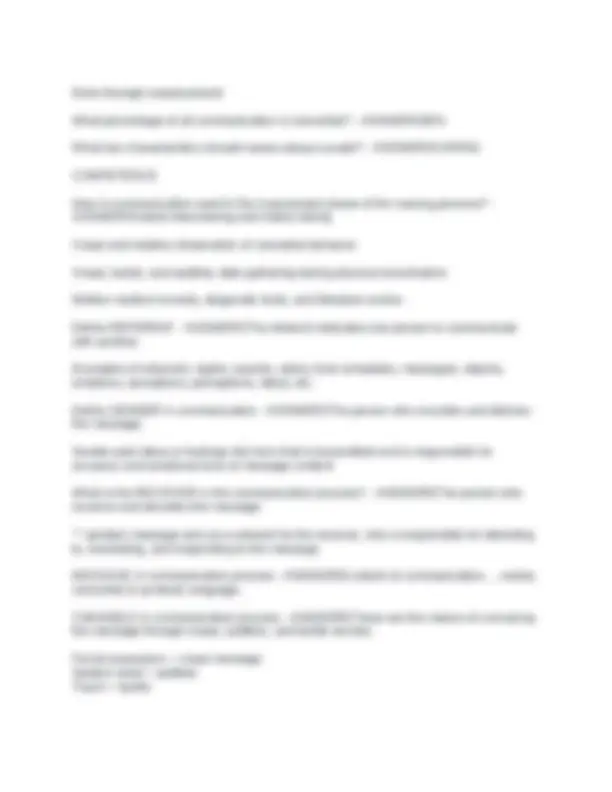
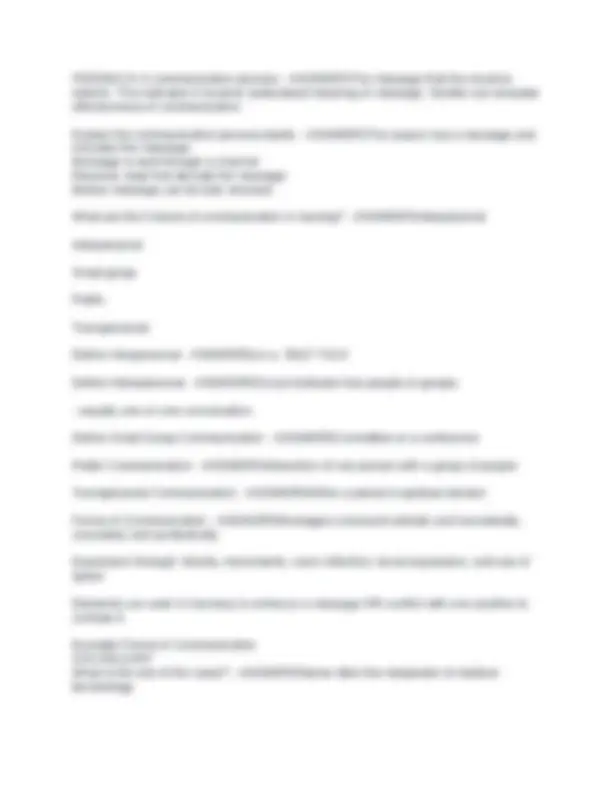
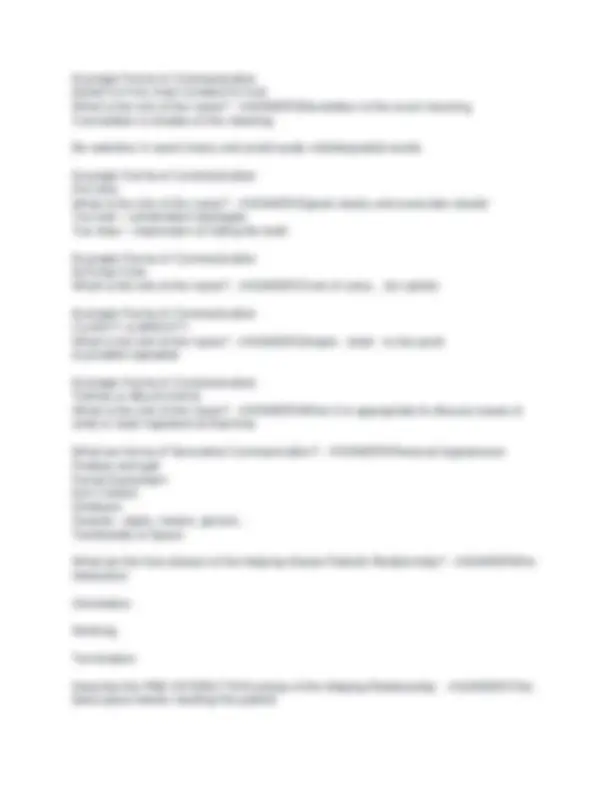
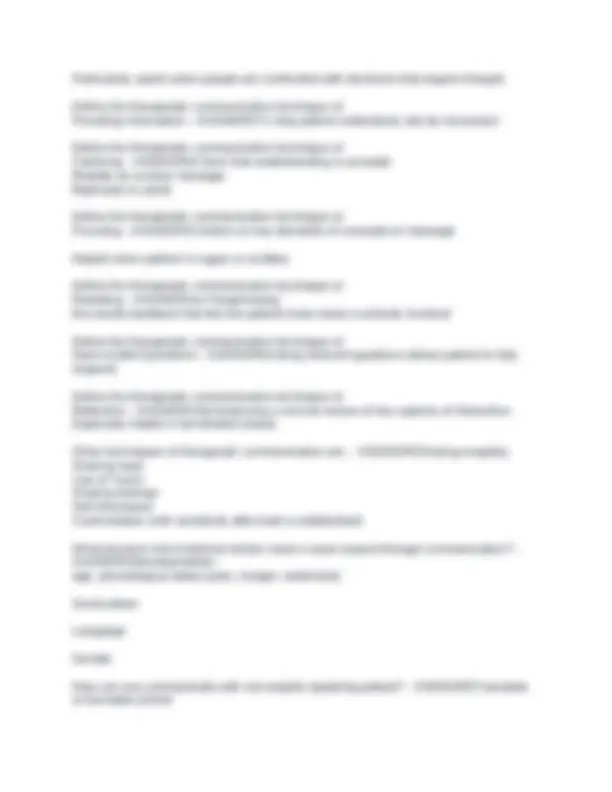
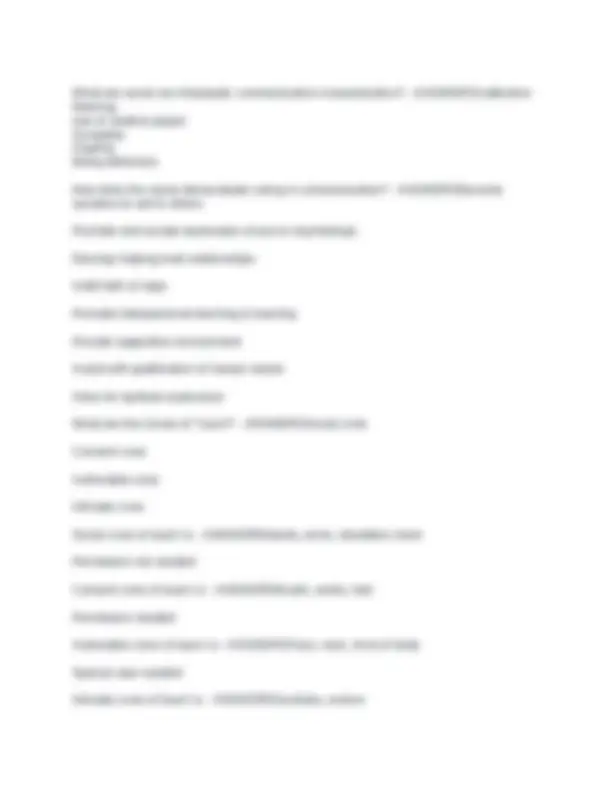

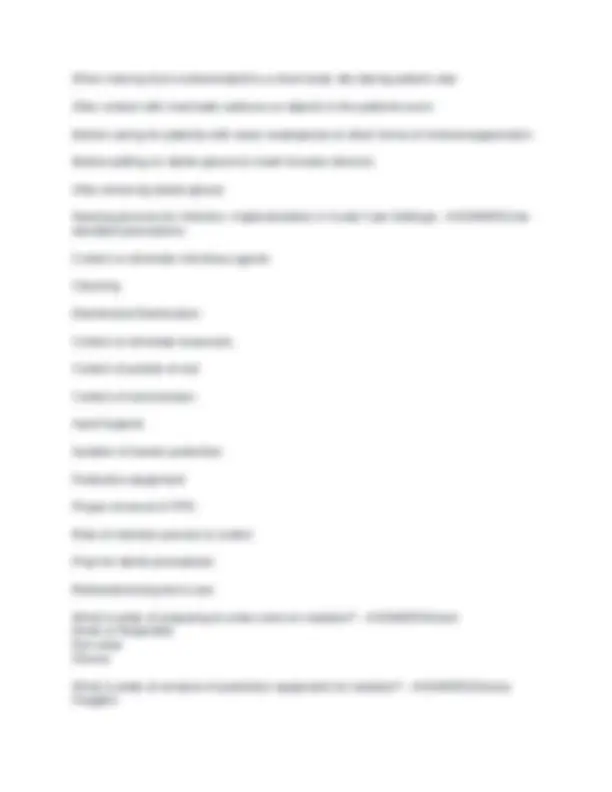
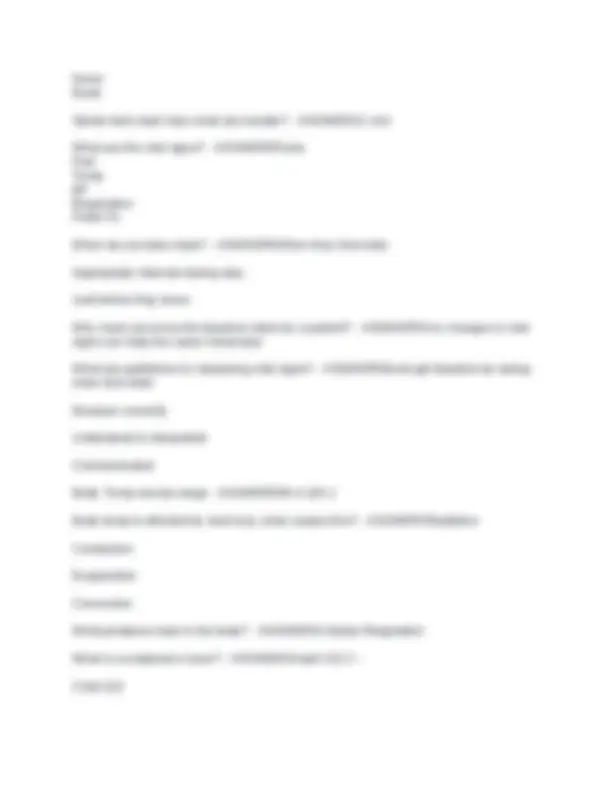
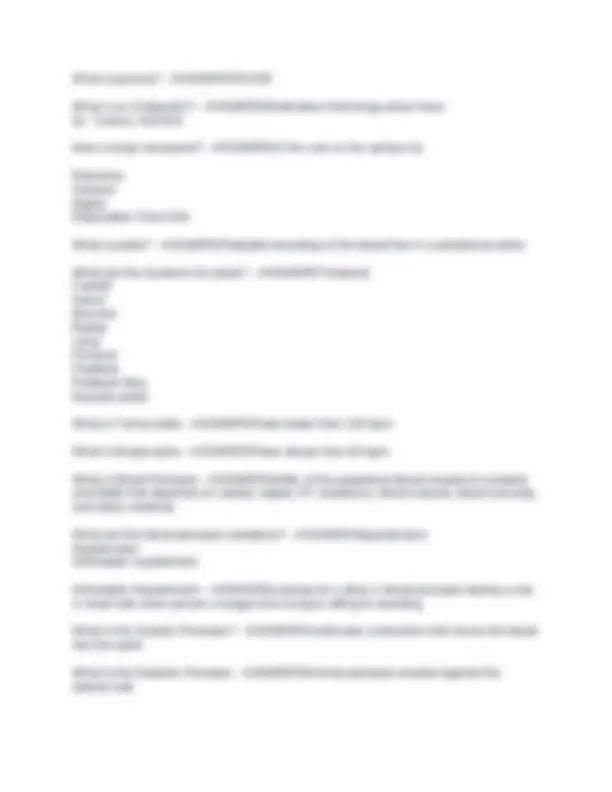
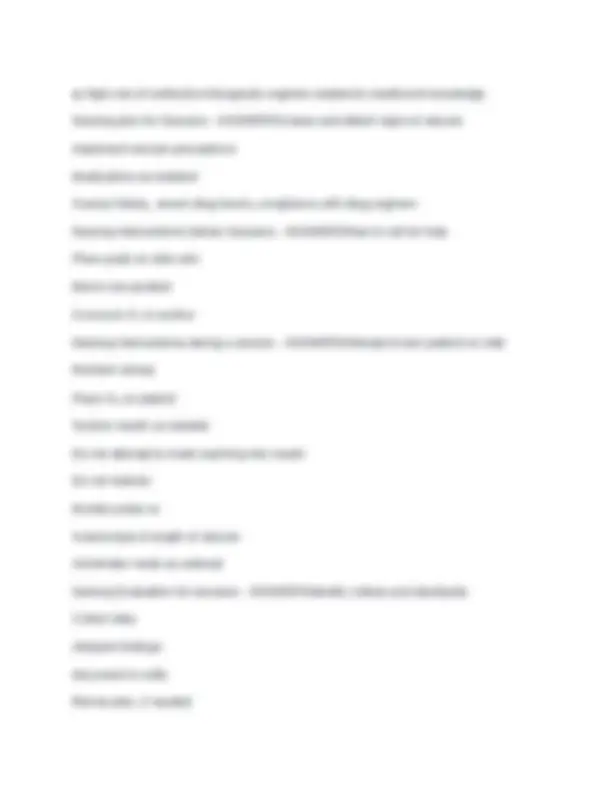
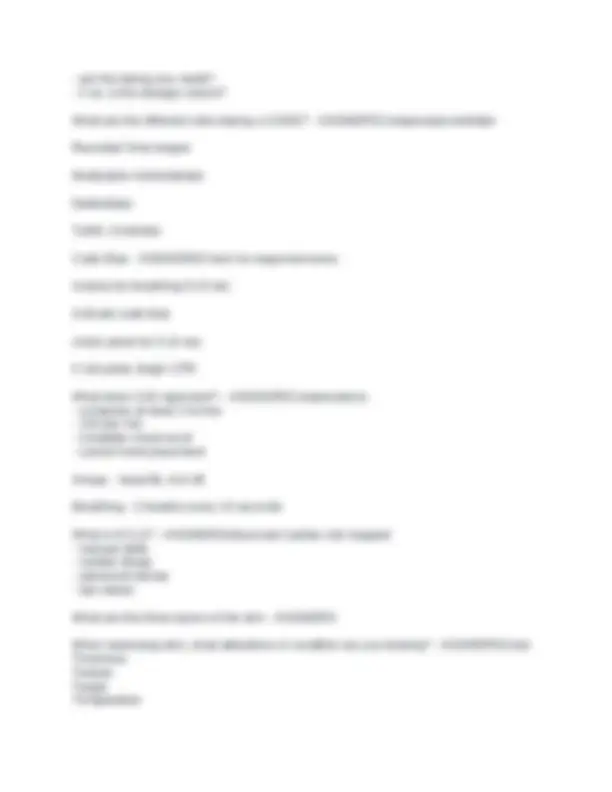
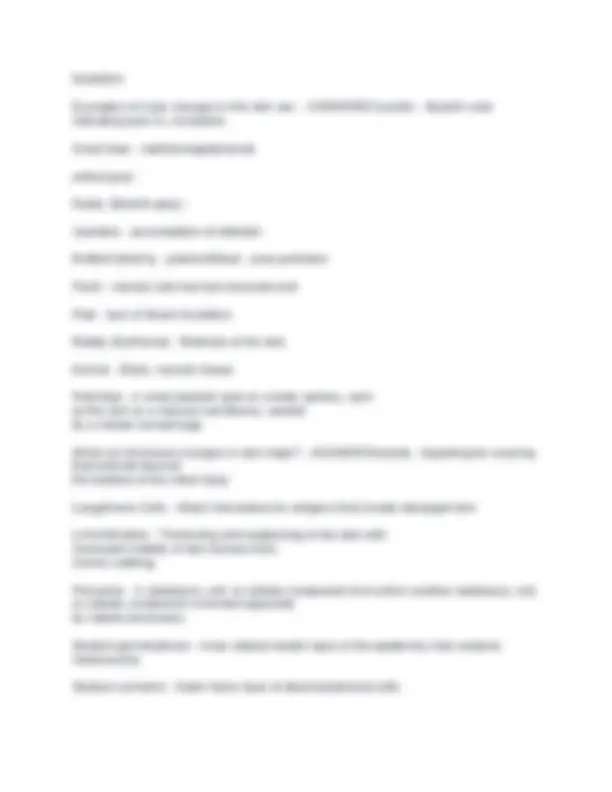
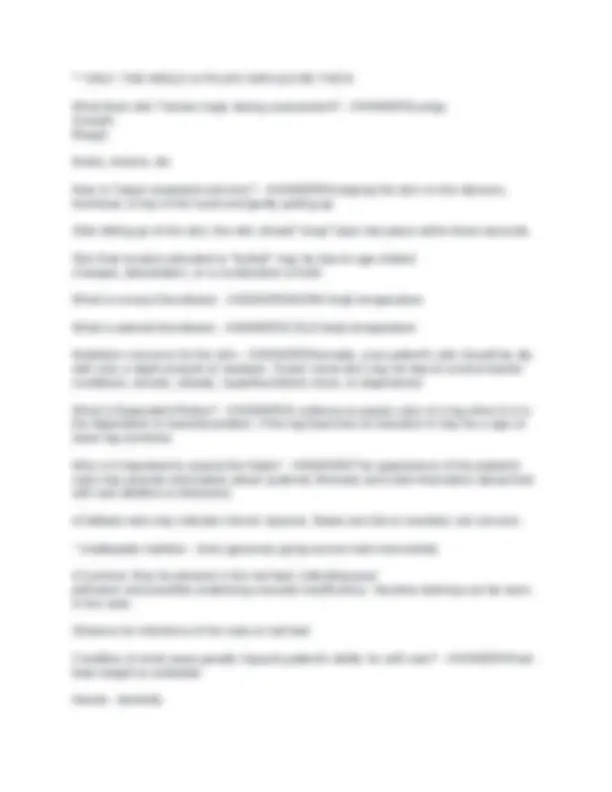
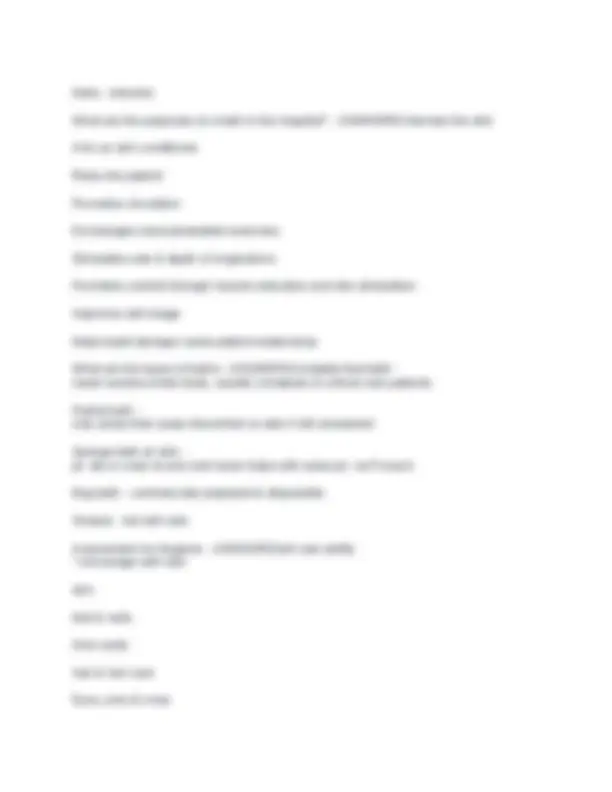
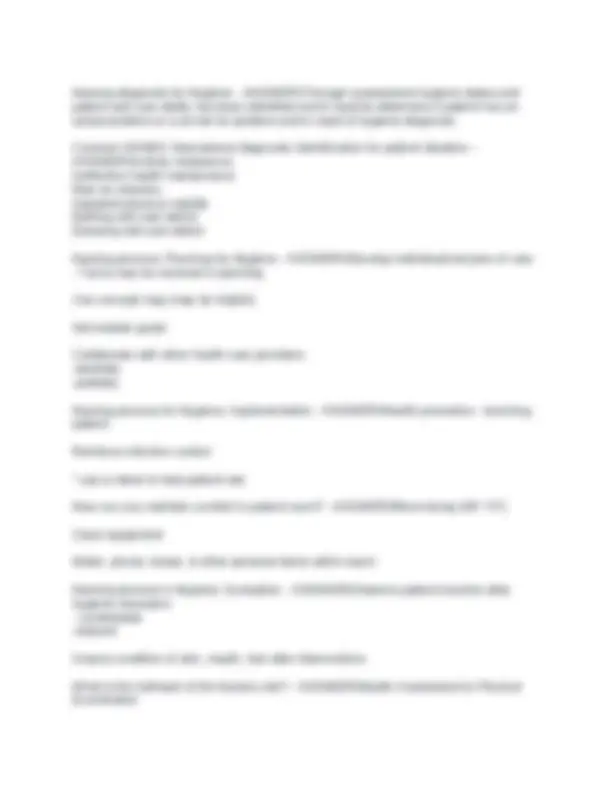
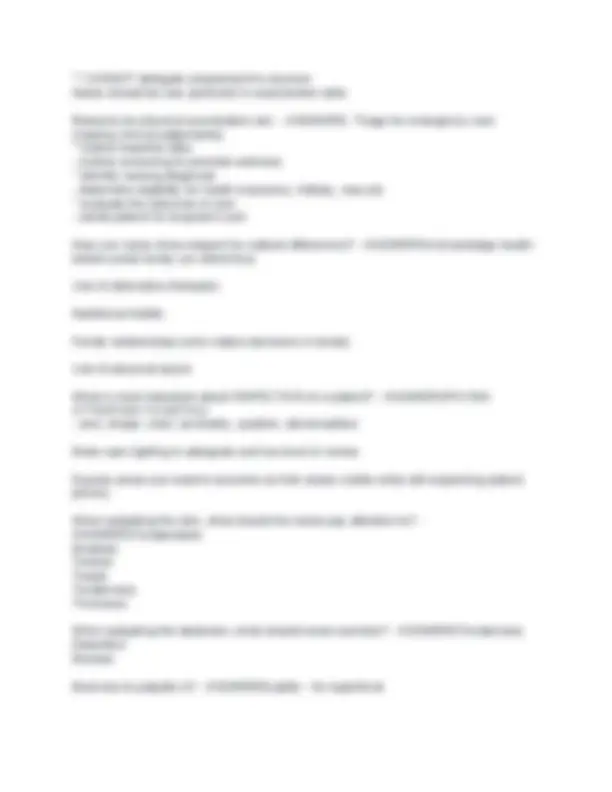
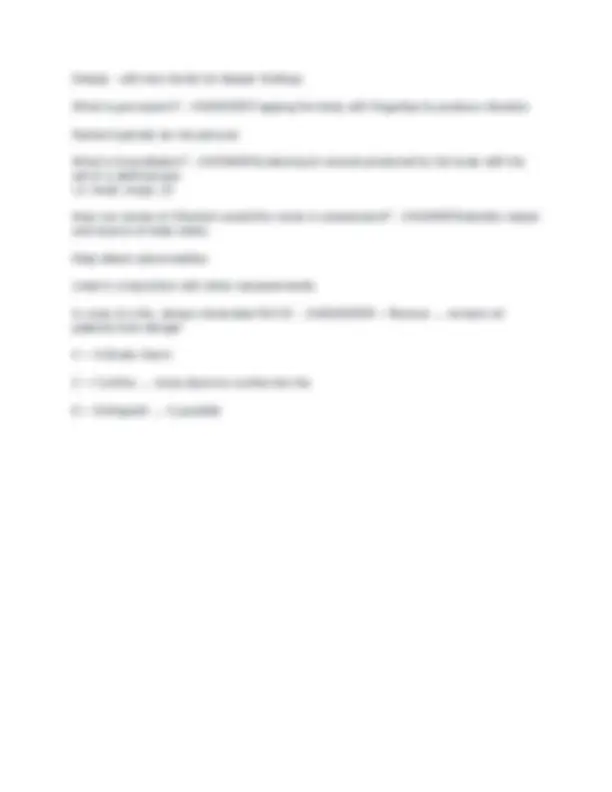


Study with the several resources on Docsity

Earn points by helping other students or get them with a premium plan


Prepare for your exams
Study with the several resources on Docsity

Earn points to download
Earn points by helping other students or get them with a premium plan
Community
Ask the community for help and clear up your study doubts
Discover the best universities in your country according to Docsity users
Free resources
Download our free guides on studying techniques, anxiety management strategies, and thesis advice from Docsity tutors
A comprehensive set of questions and answers covering key concepts in fundamental nursing practice. It explores essential roles of nurses, the nursing process, communication techniques, and the nurse-patient relationship. Particularly useful for students preparing for their first nursing exam, offering insights into common exam topics and providing a framework for understanding fundamental nursing principles.
Typology: Exams
1 / 25

This page cannot be seen from the preview
Don't miss anything!


















What are the most important roles of the nurse (5) - ANSWERSCaregiver Advocate Educator Researcher Leader What are the 5 steps in the nursing process? - ANSWERS(1) Assessment (2) Nursing Diagnosis (3) Planning (4) Implementation (5) Evaluation *** All of the above require critical thinking! Define Assessment - ANSWERSCollects comprehensive data pertinent to the patient's health and/or situation.
OBJECTIVE info is what the RN sees, hears, or smells What is the Diagnosis phase? - ANSWERSAnalyze the assessment and make a clinical judgement related to an ACTUAL or POTENTIAL health problem. ** Nurses have to be aware of potential risks based on health problems. ** Also collaborate with other specialists to manage the problem(s) What are the three phases of a Nursing Diagnosis? - ANSWERSFirst info → Related to → as evidence by WHAT is the problem? WHY is it a problem? WHAT is the evidence of that problem? Ex: "Acute pain → related to surgical incision → as evidence by patient report (or as evidence by crying)" What are the OUTCOMES IDENTIFICATION? - ANSWERSThis is the statement of how a patient's status will change once interventions have been successfully instituted Identify the expected outcomes when planning for the patient's individual situation. Interventions must be measurable criterion indicating that objectives have been met. Define the PLANNING stage of the nursing process - ANSWERSDevelops a plan that prescribes strategies and alternatives to attain expected outcomes.
FEEDBACK in communication process - ANSWERSThe message that the receiver returns. This indicates if receiver understood meaning of message. Sender can evaluate effectiveness of communication. Explain the communication process briefly - ANSWERSThe source has a message and encodes the message. Message is sent through a channel Receiver must first decode the message Before message can be fully received What are the 5 levels of communication in nursing? - ANSWERSInterpersonal Interpersonal Small group Public Transpersonal Define Intrapersonal - ANSWERSa.k.a. SELF-TALK Define Intrerpersonal - ANSWERSOccurs between two people or groups
Example Forms of Communication DENOTATIVE AND CONNOTATIVE What is the role of the nurse? - ANSWERSDenotative is the exact meaning Connotative is shades of the meaning Be selective in word choice and avoid easily misinterpreted words. Example Forms of Communication PACING What is the role of the nurse? - ANSWERSSpeak slowly and enunciate clearly! Too fast = unintended messages Too slow = impression of hiding the truth Example Forms of Communication INTONATION What is the role of the nurse? - ANSWERSTone of voice... be careful Example Forms of Communication CLARITY & BREVITY What is the role of the nurse? - ANSWERSSimple - short - to the point & possible repeated Example Forms of Communication TIMING & RELEVANCE What is the role of the nurse? - ANSWERSWhen it is appropriate to discuss issues & what is most important at that time. What are forms of Nonverbal Communication? - ANSWERSPersonal Appearance Posture and gait Facial Expression Eye Contact Gestures Sounds - sighs, moans, groans... Territoriality & Space What are the four phases of the Helping (Nurse-Patient) Relationship? - ANSWERSPre- interaction Orientation Working Termination Describe the PRE-INTERACTION phase of the Helping Relationship. - ANSWERSThis takes place before meeting the patient:
Courtesy - hello, good-bye, knock on doors, please, thank you... Use of Names - Always introduce yourself Confidentiality - HIPPA Trust - always honest! Acceptance & Respect - Non-judgmental attitudes Availability - "Anything else I can get you? Socializing - don't socialize with pt. and don't socialize with colleagues where pt's can hear What is therapeutic communication techniques? - ANSWERSSpecific responses that encourage the expression of feeling and ideas and convey acceptance and respect. Define the therapeutic communication technique of: Active Listening - ANSWERSBeing attentive to what patient is saying both verbally and nonverbally. ** Use SOLER to facilitate attentive listening Define acronym SOLER - ANSWERSS - Sit facing the patient O - Open posture L - Lean toward the patient E - Establish & maintain eye contact R - Relax Define the therapeutic communication technique of: Sharing Observations - ANSWERSObservations/perceptions can help start a conversation, but need to be careful not to anger patient or make assumptions. Define the therapeutic communication technique of: Sharing Humor - ANSWERSImportant but often underused resource in nursing interactions. It is a coping strategy that adds perspective and helps adjust to stress. Define the therapeutic communication technique of: Using Silence - ANSWERSAllow patient to break the silence, particularly when he/she has initiated it.
Particularly useful when people are confronted with decisions that require thought. Define the therapeutic communication technique of: Providing Information - ANSWERSTo help patient understand, but do not preach Define the therapeutic communication technique of: Clarifying - ANSWERSCheck that understanding is accurate Restate an unclear message Rephrase to clarify Define the therapeutic communication technique of: Focusing - ANSWERSCenters on key elements of concepts of message Helpful when patient is vague or rambles Define the therapeutic communication technique of: Restating - ANSWERSor Paraphrasing this sends feedback that lets the patient know nurse is actively involved Define the therapeutic communication technique of: Open-ended Questions - ANSWERSAsking relevant questions allows patient to fully respond Define the therapeutic communication technique of: Reflection - ANSWERSSummarizing a concise review of key aspects of interaction. Especially helpful in termination phase Other techniques of therapeutic communication are: - ANSWERSSharing empathy Sharing hope Use of Touch Sharing feelings Self-Disclosure Confrontation (with sensitivity after trust is established) What physical and emotional factors must a nurse assess through communication? - ANSWERSDevelopmental - age, physiological status (pain, hunger, weakness) Socioculture Language Gender How can you communicate with non-english speaking patient? - ANSWERSTranslator or translator phone
Great sensitivity needed Zones of Personal Space - ANSWERSIntimate - 0-18" Personal - 18" - 4' Social - 4 -12 ft Public - > 12 ft What is Intimate zone of personal space? - ANSWERSHolding crying infant Performing physical assessment Bathing, grooming, dressing, feeding, and toileting a patient Changing patient dressing What is Personal Zone of personal space? - ANSWERSSitting at a patient's bedside Taking patient history Teaching patient Exchanging info at shift change What is Social Zone of personal space? - ANSWERSMaking rounds with physician Sitting at the head of a conference table Teaching a class for patients with diabetes Conducting family support What is public zone of personal space? - ANSWERSSpeaking at a community forum Testifying at a legislative hearing Lecturing to a class of students INFECTION PHYSIOLOGY....... - ANSWERSSEE NOTECARDS FOR MED-SURG EXAM, PART ONE to review vocabulary and basic understanding. THEN... proceed in this set of flashcards for the Nursing Care of Infections
Nursing process for Infection: Assessment - ANSWERSAssess all risk factors: age, nutrition, diagnostic procedures (IV, catheters), occupation, high-risk behaviors, travel history, trauma, stress Nutritional Status
When moving from contaminated to a clean body site during patient care After contact with inanimate surfaces or objects in the patients room Before caring for patients with sever neutropenia or other forms of immunosuppression Before putting on sterile gloves to insert invasive devices After removing sterile gloves Nursing process for Infection: Implementation in Acute Care Settings - ANSWERSUse standard precautions Control or eliminate infectious agents Cleaning Disinfection/Sterilization Control or eliminate reservoirs Control of portals of exit Control of transmission hand hygiene Isolation & barrier protection Protective equipment Proper removal of PPE Role of infection prevent & control Prep for sterile procedures Restorative/long-term care What is order of preparing to enter room on isolation? - ANSWERSGown Mask or Respirator Eye wear Gloves What is order of removal of protective equipment for isolation? - ANSWERSGloves Goggles
Gown Mask Sterile field must have what size border? - ANSWERS1 inch What are the vital signs? - ANSWERSPulse Pain Temp BP Respiration Pulse Ox When do you take vitals? - ANSWERSWhen they first enter Appropriate intervals during stay Just before they leave Why must you know the baseline vitals for a patient? - ANSWERSAny changes in vital signs can help the nurse immensely What are guidelines to measuring vital signs? - ANSWERSMust get baseline by taking when first enter Measure correctly Understood & interpreted Communicated Body Temp normal range - ANSWERS96.4-100. Body temp is affected by heat loss, what causes this? - ANSWERSRadiation Conduction Evaporation Convection What produces heat in the body? - ANSWERSCellular Respiration What is considered a fever? - ANSWERSAdult 102.2 ↑ Child 104
concussion Infection Metabolic disorders Withdraw from alcohol Idiopathic (no known cause) How do you assess a seizure? - ANSWERSWas seizure seen Precipitating factors Where did it start How did it progress Type of movement in extremities Gaze deviation Incontinence? Mental status How long did seizure last? Mental status after seizure? Motor weakness after seizure Any injury from seizure Another term for a seizure? - ANSWERSIrritable focus -or- Foci What is Postictal Phase? - ANSWERSAltered state of consciousness that a person enters after experiencing a seizure. It usually lasts between 5 and 30 min, and is characterized by drowsiness, confusion, nausea, hypertension, headache or migraine and other disorienting symptoms. Nursing Diagnosis for Seizures - ANSWERS⊗ Risk for injury ⊗ Risk for aspiration - breathing fluid into lungs ⊗ Ineffective airway clearance related to relaxation of tongue and gag reflex secondary to muscle innervation ⊗ Anxiety
Hydration Examples of color changes in the skin are: - ANSWERSCyanotic - blueish color indicating poor O₂ circulation. Smurf blue - methhemoglobinemia yellow-gray - Dusky (blueish-gray) - Jaundice - accumulation of billirubin Mottled (blotchy - pale/red/blue) - poor perfusion Flush - normal color but face becomes red Pale - lack of blood circulation Ruddy (Erythema) - Redness of the skin. Eschar - Black, necrotic tissue. Petichiae - A small purplish spot on a body surface, such as the skin or a mucous membrane, caused by a minute hemorrhage What can thickness changes in skin imply? - ANSWERSKeloids - Hypertrophic scarring that extends beyond the borders of the initial injury. Langerhans Cells - Attach themselves to antigens that invade damaged skin. Lichenification - Thickening and roughening of the skin with increased visibility of skin furrows from chronic rubbing. Precursor - A substance, cell, or cellular component from which another substance, cell, or cellular component is formed especially by natural processes. Stratum germinativum - Inner cellular keratin layer of the epidermis, that contains melanocytes. Stratum corneum - Outer horny layer of dead keratinized cells